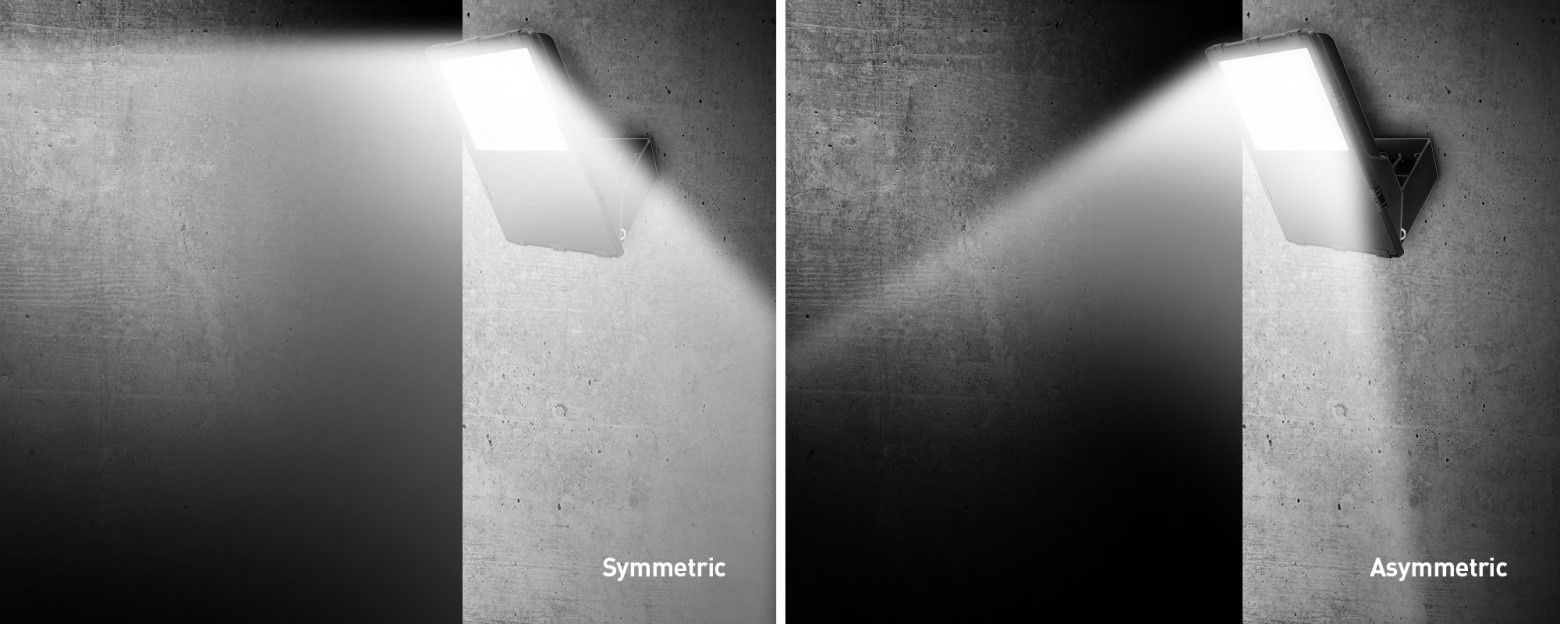
Introduction
Lighting distribution simply refers to how light is dispersed from a luminaire. It is the amount of light that the luminaire projects into each solid angle of the space. For unique lighting applications, different light distribution patterns need to be considered. Each lighting distribution provides a unique lighting footprint or pattern to meet the needs of your lighting application.
What’s symmetric and asymmetric lighting distribution :
LED lamps are usually composed of multiple LEDs. In order to achieve the expected luminous flux and light distribution, strict secondary optical design must be carried out according to the light distribution of each LED. LED lamps generally have complex geometric shapes and light-emitting surfaces, and there will be obvious differences in light distribution at a distance from the lamp and near the lamp.
After design, if the light distribution generated by the lamp is uniformly distributed throughout the area, the light distribution is symmetrical; if the light generated by the lamp is unevenly distributed throughout the area, the light distribution is asymmetrical.
A symmetrical lighting distribution involves using a fixture to spread light in a uniform or symmetrical (centered on an axis, with the same light intensity in all directions) pattern, while an asymmetrical lighting distribution involves using a fixture in an uneven or asymmetrical pattern to spread light. These are mainly achieved through the secondary optical design of the lamps. The following is the Intensity distribution diagram of the asymmetric and symmetric light distribution of street lamps.
We can see that the asymmetric light distribution is asymmetric except for the light intensity distribution on the C0/180 plane, and the rest of the planes are asymmetric. In practical application, we can install the street light on one side of the road to evenly illuminate the entire road surface.

Conclusion :
Choosing between symmetrical and asymmetrical lighting distribution depends on the goals of the lighting design, the architectural features of the space, and the desired visual effects. Symmetrical lighting is more suited for providing general illumination and a balanced environment, while asymmetrical lighting is used for creating focal points, emphasizing specific areas, and achieving more dramatic visual effects. Oftentimes, a combination of both symmetrical and asymmetrical lighting techniques can be used to achieve a well-rounded and visually appealing lighting design.
Application of symmetrical lighting distribution
Symmetrical LED light distributes light evenly in all directions. This type of light distribution is recommended for indoor lighting, general lighting of large spaces and landscape lighting etc. For example, in our bedroom, a down light with symmetrical light distribution is often enough or the floodlights at the intersection, due to the large illuminated area and the high installation height of the lamps, the symmetrical light distribution is more suitable for illuminating the entire intersection to ensure the safety of pedestrians and drivers.
Advantages of symmetrical light distribution :
1. Large space lighting:
The lighting with symmetrical light distribution is more suitable for large space lighting. Unlike asymmetric lighting, symmetrical lighting doesn't focus light on specific areas. Instead, it spreads the beam evenly in all directions to ensure that every corner of a large space is illuminated
2. Easy to install :
Since the lighting with symmetrical light distribution will not focus the light beam on a specific area, we don't have to pay too much attention to the installation angle of the luminaire. Generally, when you need to light that area, you just point the light emitting surface of the light fixture in that direction.
Disadvantages of symmetrical light distribution :
Symmetrical light distribution tends to illuminate areas where it is not needed, thus causing light pollution
Luminaires with symmetrical light distribution are not energy efficient compared to asymmetrical light distribution
Symmetrical lighting can cause both intentional and unintentional glare
Application of Asymmetric lighting :
Asymmetrical lighting is your best choice when you want to brighten a specific space. You had better to choose asymmetrical lighting when you want to accentuate any particular area of your project space. Asymmetric lighting is suitable for many places such as roads, parking lots, gas stations, professional stadiums, perimeter lighting, wall-washing, grazing, street lighting, etc.
The lighting in these areas has a common characteristic that the lighting area is clear. So there will not be too much light irradiated outside the area. For example, road lighting requires that the light be mainly irradiated on the road, but not on the houses and grass. Stadium lighting requires no spillage and too much light will affect the daily life of people in residential areas near the stadium.
Advantages of asymmetrical light distribution :
1. Illuminate specific areas :
Lighting unnecessary areas is a complete waste. So, asymmetrical lights only illuminate the area that needs to be illuminated. Illumination through asymmetrical light distribution produces little or no light pollution
2. Limited light source :
Asymmetrical lighting creates narrow beams of light to illuminate intended areas. It uses the least amount of energy to illuminate the target area, so it is more energy efficient than symmetrical light distribution solutions
3. Cost-effective :
Asymmetric lighting directs all light as evenly as possible onto the target area. Therefore, in addition to saving electric energy, asymmetric lighting can also achieve the most ideal lighting effect which can be said to achieve the best lighting effect at the lowest cost
Disadvantages of asymmetrical lighting :
Asymmetric lighting is not suitable for general lighting, such as your bedroom lighting, office lighting and some other indoor lighting. Instead, it is more suitable for accomplishing specific lighting tasks
Asymmetrical light distribution places higher demands on lighting users. Generally, users are required to have a certain understanding of the light distribution, and can reasonably use lighting simulation software to select the light distribution to find a suitable installation plan, including installation height, layout of poles(street and flood lighting) and installation angle